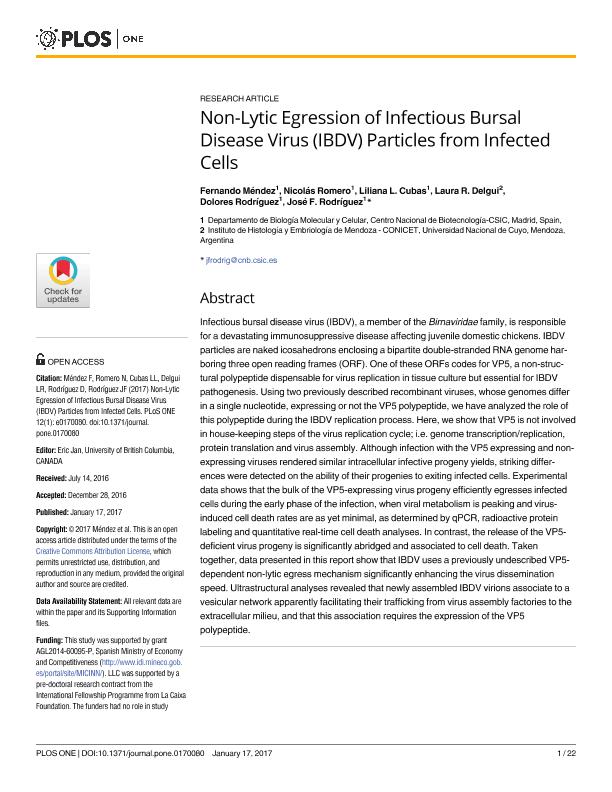Mostrar el registro sencillo del ítem
dc.contributor.author
Méndez, Fernando
dc.contributor.author
Romero, Nicolás
dc.contributor.author
Cubas, Liliana L.
dc.contributor.author
Delgui, Laura Ruth

dc.contributor.author
Rodriguez, Dolores
dc.contributor.author
Rodríguez, José F.
dc.date.available
2018-06-15T22:06:42Z
dc.date.issued
2017-01
dc.identifier.citation
Méndez, Fernando; Romero, Nicolás; Cubas, Liliana L.; Delgui, Laura Ruth; Rodriguez, Dolores; et al.; Non-lytic egression of infectious bursal disease virus (IBDV) particles from infected cells; Public Library of Science; Plos One; 12; 1; 1-2017; 1-22
dc.identifier.issn
1932-6203
dc.identifier.uri
http://hdl.handle.net/11336/48922
dc.description.abstract
nfectious bursal disease virus (IBDV), a member of the Birnaviridae family, is responsible for a devastating immunosuppressive disease affecting juvenile domestic chickens. IBDV particles are naked icosahedrons enclosing a bipartite double-stranded RNA genome harboring three open reading frames (ORF). One of these ORFs codes for VP5, a non-structural polypeptide dispensable for virus replication in tissue culture but essential for IBDV pathogenesis. Using two previously described recombinant viruses, whose genomes differ in a single nucleotide, expressing or not the VP5 polypeptide, we have analyzed the role of this polypeptide during the IBDV replication process. Here, we show that VP5 is not involved in house-keeping steps of the virus replication cycle; i.e. genome transcription/replication, protein translation and virus assembly. Although infection with the VP5 expressing and non-expressing viruses rendered similar intracellular infective progeny yields, striking differences were detected on the ability of their progenies to exiting infected cells. Experimental data shows that the bulk of the VP5-expressing virus progeny efficiently egresses infected cells during the early phase of the infection, when viral metabolism is peaking and virus-induced cell death rates are as yet minimal, as determined by qPCR, radioactive protein labeling and quantitative real-time cell death analyses. In contrast, the release of the VP5-deficient virus progeny is significantly abridged and associated to cell death. Taken together, data presented in this report show that IBDV uses a previously undescribed VP5-dependent non-lytic egress mechanism significantly enhancing the virus dissemination speed. Ultrastructural analyses revealed that newly assembled IBDV virions associate to a vesicular network apparently facilitating their trafficking from virus assembly factories to the extracellular milieu, and that this association requires the expression of the VP5 polypeptide.
dc.format
application/pdf
dc.language.iso
eng
dc.publisher
Public Library of Science

dc.rights
info:eu-repo/semantics/openAccess
dc.rights.uri
https://creativecommons.org/licenses/by-nc-sa/2.5/ar/
dc.subject
Ibdv,
dc.subject
Birnavirus
dc.subject
Virus Egress
dc.subject
Virus Dissemination
dc.subject.classification
Otras Ciencias Biológicas

dc.subject.classification
Ciencias Biológicas

dc.subject.classification
CIENCIAS NATURALES Y EXACTAS

dc.title
Non-lytic egression of infectious bursal disease virus (IBDV) particles from infected cells
dc.type
info:eu-repo/semantics/article
dc.type
info:ar-repo/semantics/artículo
dc.type
info:eu-repo/semantics/publishedVersion
dc.date.updated
2018-06-13T16:52:18Z
dc.journal.volume
12
dc.journal.number
1
dc.journal.pagination
1-22
dc.journal.pais
Estados Unidos

dc.journal.ciudad
San Francisco
dc.description.fil
Fil: Méndez, Fernando. Consejo Superior de Investigaciones Científicas. Centro Nacional de Biotecnología; España
dc.description.fil
Fil: Romero, Nicolás. Consejo Superior de Investigaciones Científicas. Centro Nacional de Biotecnología; España
dc.description.fil
Fil: Cubas, Liliana L.. Consejo Superior de Investigaciones Científicas. Centro Nacional de Biotecnología; España
dc.description.fil
Fil: Delgui, Laura Ruth. Consejo Nacional de Investigaciones Científicas y Técnicas. Centro Científico Tecnológico Conicet - Mendoza. Instituto de Histología y Embriología de Mendoza Dr. Mario H. Burgos. Universidad Nacional de Cuyo. Facultad de Cienicas Médicas. Instituto de Histología y Embriología de Mendoza Dr. Mario H. Burgos; Argentina
dc.description.fil
Fil: Rodriguez, Dolores. Consejo Superior de Investigaciones Científicas. Centro Nacional de Biotecnología; España
dc.description.fil
Fil: Rodríguez, José F.. Consejo Superior de Investigaciones Científicas. Centro Nacional de Biotecnología; España
dc.journal.title
Plos One

dc.relation.alternativeid
info:eu-repo/semantics/altIdentifier/doi/http://dx.doi.org/10.1371/journal.pone.0170080
dc.relation.alternativeid
info:eu-repo/semantics/altIdentifier/url/http://journals.plos.org/plosone/article?id=10.1371/journal.pone.0170080
Archivos asociados
